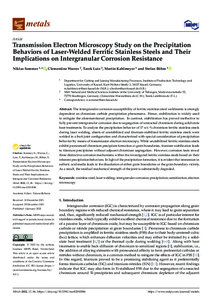Datum
2022-01-04Schlagwort
620 Ingenieurwissenschaften Nicht rostender StahlLaserschweißenInterkrisalline KorrosionNiederschlagElektronenmikroskopMetadata
Zur Langanzeige
Aufsatz

Transmission Electron Microscopy Study on the Precipitation Behaviors of Laser-Welded Ferritic Stainless Steels and Their Implications on Intergranular Corrosion Resistance
Zusammenfassung
The intergranular corrosion susceptibility of ferritic stainless-steel weldments is strongly dependent on chromium carbide precipitation phenomena. Hence, stabilization is widely used to mitigate the aforementioned precipitation. In contrast, stabilization has proved ineffective to fully prevent intergranular corrosion due to segregation of unreacted chromium during solid-state heat-treatments. To analyze the precipitation behavior of 17 wt.-% chromium ferritic stainless steels during laser welding, sheets of unstabilized and titanium-stabilized ferritic stainless steels were welded in a butt joint configuration and characterized with special consideration of precipitation behavior by means of transmission electron microscopy. While unstabilized ferritic stainless steels exhibit pronounced chromium precipitate formation at grain boundaries, titanium-stabilization leads to titanium precipitates without adjacent chromium segregation. However, corrosion tests reveal three distinctive corrosion mechanisms within the investigated ferritic stainless steels based on their inherent precipitation behaviors. In light of the precipitation formation, it is evident that immersion in sulfuric acid media leads to the dissolution of either grain boundaries or the grain boundary vicinity. As a result, the residual mechanical strength of the joint is substantially degraded.
Zitierform
In: Metals Volume 12 / Issue 1 (2022-01-04) eissn:2075-4701Förderhinweis
Gefördert durch den Publikationsfonds der Universität KasselZitieren
@article{doi:10.17170/kobra-202203145879,
author={Sommer, Niklas and Warres, Clementine and Lutz, Tarek and Kahlmeyer, Martin and Böhm, Stefan},
title={Transmission Electron Microscopy Study on the Precipitation Behaviors of Laser-Welded Ferritic Stainless Steels and Their Implications on Intergranular Corrosion Resistance},
journal={Metals},
year={2022}
}
0500 Oax
0501 Text $btxt$2rdacontent
0502 Computermedien $bc$2rdacarrier
1100 2022$n2022
1500 1/eng
2050 ##0##http://hdl.handle.net/123456789/13697
3000 Sommer, Niklas
3010 Warres, Clementine
3010 Lutz, Tarek
3010 Kahlmeyer, Martin
3010 Böhm, Stefan
4000 Transmission Electron Microscopy Study on the Precipitation Behaviors of Laser-Welded Ferritic Stainless Steels and Their Implications on Intergranular Corrosion Resistance / Sommer, Niklas
4030
4060 Online-Ressource
4085 ##0##=u http://nbn-resolving.de/http://hdl.handle.net/123456789/13697=x R
4204 \$dAufsatz
4170
5550 {{Nicht rostender Stahl}}
5550 {{Laserschweißen}}
5550 {{Interkrisalline Korrosion}}
5550 {{Niederschlag}}
5550 {{Elektronenmikroskop}}
7136 ##0##http://hdl.handle.net/123456789/13697
<resource xsi:schemaLocation="http://datacite.org/schema/kernel-2.2 http://schema.datacite.org/meta/kernel-2.2/metadata.xsd"> 2022-03-14T13:33:34Z 2022-03-14T13:33:34Z 2022-01-04 doi:10.17170/kobra-202203145879 http://hdl.handle.net/123456789/13697 Gefördert durch den Publikationsfonds der Universität Kassel eng Namensnennung 4.0 International http://creativecommons.org/licenses/by/4.0/ stainless steel laser welding intergranular corrosion precipitation sensitization electron microscopy 620 Transmission Electron Microscopy Study on the Precipitation Behaviors of Laser-Welded Ferritic Stainless Steels and Their Implications on Intergranular Corrosion Resistance Aufsatz The intergranular corrosion susceptibility of ferritic stainless-steel weldments is strongly dependent on chromium carbide precipitation phenomena. Hence, stabilization is widely used to mitigate the aforementioned precipitation. In contrast, stabilization has proved ineffective to fully prevent intergranular corrosion due to segregation of unreacted chromium during solid-state heat-treatments. To analyze the precipitation behavior of 17 wt.-% chromium ferritic stainless steels during laser welding, sheets of unstabilized and titanium-stabilized ferritic stainless steels were welded in a butt joint configuration and characterized with special consideration of precipitation behavior by means of transmission electron microscopy. While unstabilized ferritic stainless steels exhibit pronounced chromium precipitate formation at grain boundaries, titanium-stabilization leads to titanium precipitates without adjacent chromium segregation. However, corrosion tests reveal three distinctive corrosion mechanisms within the investigated ferritic stainless steels based on their inherent precipitation behaviors. In light of the precipitation formation, it is evident that immersion in sulfuric acid media leads to the dissolution of either grain boundaries or the grain boundary vicinity. As a result, the residual mechanical strength of the joint is substantially degraded. open access Sommer, Niklas Warres, Clementine Lutz, Tarek Kahlmeyer, Martin Böhm, Stefan doi:10.3390/met12010086 Nicht rostender Stahl Laserschweißen Interkrisalline Korrosion Niederschlag Elektronenmikroskop publishedVersion eissn:2075-4701 Issue 1 Metals Volume 12 false 0086 </resource>
Die folgenden Lizenzbestimmungen sind mit dieser Ressource verbunden:


